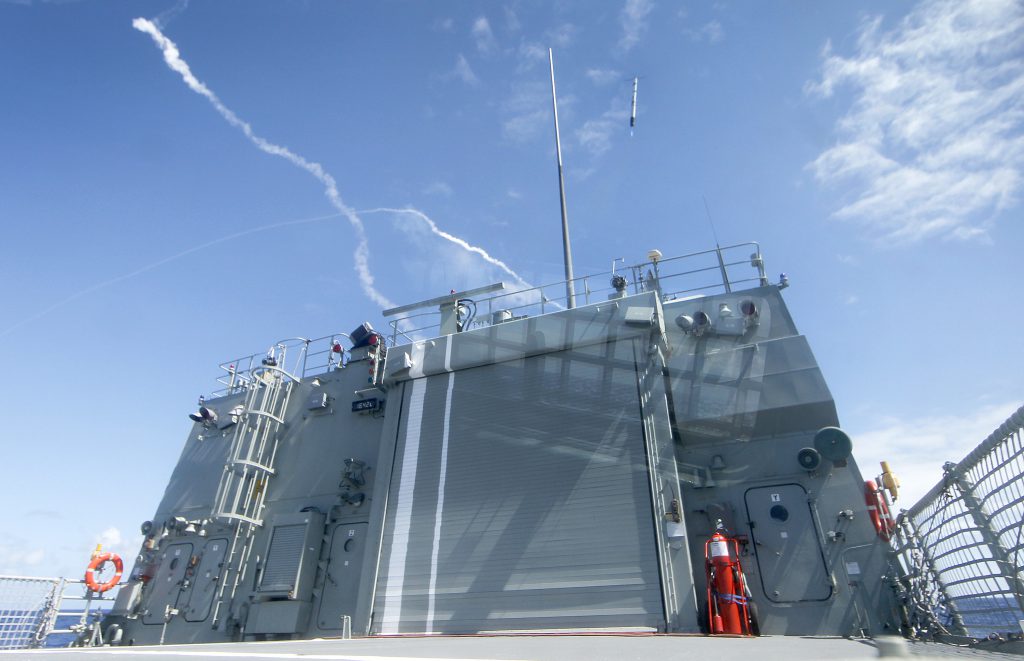
I was permitted a point of pride late last year when
reports came in that Australia’s decoy rocket, Nulka, diverted a missile attack on the American warship USS
Mason off the coast of Yemen. As always, success has a hundred fathers, and credit for the failed missile attack is also being claimed for a couple of fired SM-2s and an evolved Seasparrow. An investigation is underway. The defence industry minister, Christopher Pyne, has no doubt about Australia’s singular role,
observing in London recently: ‘A US warship, the USS
Mason, was recently attacked while off the coast of Yemen by Houthi rebels with what was believed to be land‑based anti‑ship cruise missiles. Fortunately, the ship was equipped with Australian-made Nulka decoys which were deployed, and the missiles crashed into the sea.’
Nulka is cutting-edge technology and our largest defence export. It’s a product of an exchange I had with the then US Defense Secretary Cap Weinberger in the mid-1980s. Some of it’s told in the
Defence Department’s book,
Nulka: a compelling story—ingenuity, partnership, perseverance. At the time, I was annoyed by our inability to get the codes for the APG 65 radar on the RAAF’s F-18s. The codes supplied to us could only identify Warsaw Pact aircraft as foes when most of our potential targets were Western-sourced. Further, we were then the second largest arms customer for the US defence industry, with nothing to show on the other side of the ledger.
Before the meeting, the department gave me an extensive briefing paper requesting I sign off the termination of then developmental Project Winnin (now Nulka). I didn’t sign it but it was in my notes carried into the meeting. I started with my whinges. Weinberger interrupted me and said, ‘I am sick of your whining but you never give me something concrete.’ I thought he needed an answer and, as luck would have it, one was to hand. I dragged out the briefing paper and replied, ‘How about this then?’ His advisers were aware of the planned cancellation and showed visible consternation. ‘Done’, he immediately responded. He turned to his alarmed folk and said, ‘Make it happen—no argument.’
Later, at the inaugural meeting of
AUSMIN in San Francisco in August 1986, we signed off on an agreement to collaborate on full-scale development of the concept developed by our then Defence Science and Technology Organisation. As well as being in service on our warships, the Nulka system is now deployed on many American vessels and, after the
Mason incident, I suspect it’ll appear on more.
At the time, and at that stage of development, Nulka was more symbolic. A lot of work had to be done, particularly on the payload, and largely at the American end. The challenge was to produce a signature more powerful for the homing system of an incoming missile than that registered by the ship which launched it. Nulka became an important symbol for both Australian defence science and Australian defence industry. It was important, too, for the alliance as a two-way street. For me, it assuaged some of the sorrow at the removal of New Zealand from the process of the annual meetings.
It’s now a symbol of something else entirely: the possibilities for advanced Australian manufacturing. Protectionism’s back on the table but our protected industries are either gone or their remaining elements, globally competitive. A protected market of 24 million sitting in a regional market of 3 billion makes no sense for an investor anymore. That horse has bolted, and the gate can’t sensibly be closed.
Our manufacturing future lies in niche products, internationally collaborative enterprises and global supply chains. Nulka ticks all these boxes. As a
BAE Systems Australia publication points out, it’s the prime contractor and systems design agent. Lockheed Martin (USA) is the design agent for the electronic warfare payload. Aerojet Inc. (USA) manufactures the rocket motor. BAE Systems builds the flight control hardware in Edinburgh Parks, South Australia, and tests and assembles the system at its Nulka Round Assembly Facility in Mulwala, New South Wales. These are a powerful group of defence manufacturers. As well as being our largest regular defence export program, Nulka is subject to continual development to keep it ahead of emerging countermeasures.
The Nulka story is part of the ballast of our alliance relationship as we seek to influence the direction of president-elect Donald Trump’s policy in our region in particular. The Nulka system will be part of the defences of the new warships ships
he plans to construct.
Now’s not an easy time. Our region will want us to spend a great deal of our political capital trying to alter what’s an obvious predilection on the part of the incoming Trump administration to nationalist unilateralism—a direction which may destabilise hopes for peace and prosperity. Six years ago we spent some of that capital influencing the Obama administration, classic American liberal internationalists, to extend that approach to the Asian pivot. They fitted in well, ticking all the boxes Asians demand of their international community—basically, being there and engaging. That’s going to be a lot harder after 20 January.
 Print This Post
Print This Post